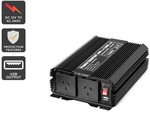Free delivery with First
Extra 25% off when automotive products are added to the cart.
Engineered to handle the rigours of caravan and RV life, and built with a peak power output of 2000W, this inverter is the ultimate solution for up to 240V power supply when off the grid, powering the most-sensitive of appliances.
Converts DC 12V to AC 240V
Compatible with any 12V battery
Continuous 1000W power output
Offers a steady and precise output voltage
Ideal for in-car use, powering notebooks and power banks
Includes USB output
Features overload, temperature, voltage and short circuit protection.



…"powering the most-sensitive of appliances."
I wouldn't trust that being modified sine wave.